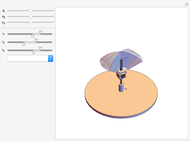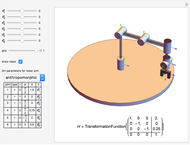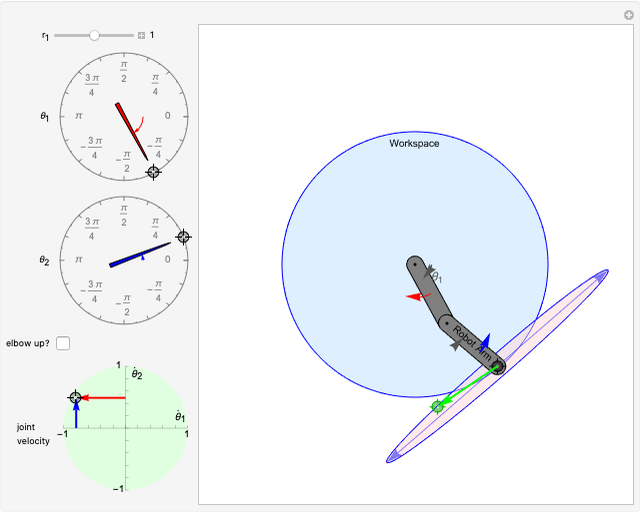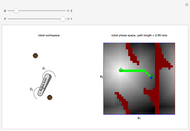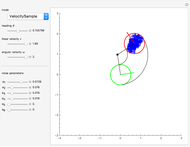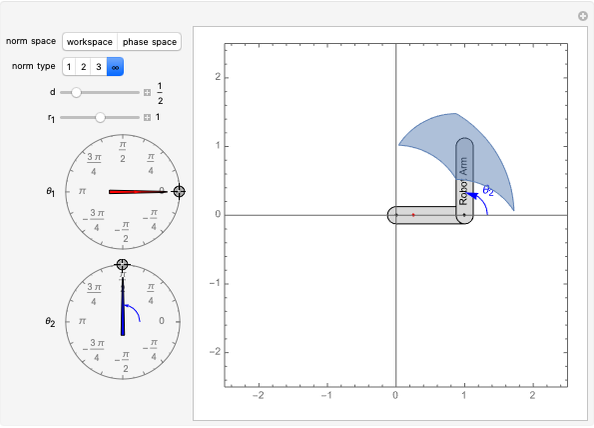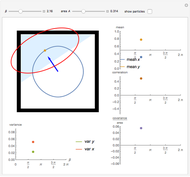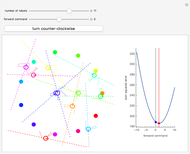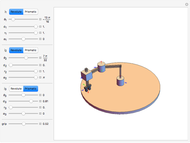Denavit-Hartenberg Parameters for a Three-Link Robot

Requires a Wolfram Notebook System
Interact on desktop, mobile and cloud with the free Wolfram Player or other Wolfram Language products.
The Denavit–Hartenberg (DH) convention for assigning coordinate frames uses four variables to define the reference coordinate frame for each link in a robotic arm. This Demonstration lets you select a three-link combination of revolute (rotating) and prismatic (sliding) joints. You can then vary their DH parameters to create a variety of robot arms in different configurations.
Contributed by: Aaron T. Becker and Mary Burbage (June 2016)
Open content licensed under CC BY-NC-SA
Snapshots
Details
The Denavit–Hartenberg (DH) convention is used to assign coordinate frames to each joint of a robot manipulator in a simplified and consistent fashion [1]. From these parameters, a homogeneous transformation matrix can be defined, which is useful for both forward and inverse kinematics of the manipulator. This homogeneous transformation is the product of four simpler transformations: (1) a rotation  about the
about the  axis, (2) a translation
axis, (2) a translation  along the
along the  axis, (3) a translation
axis, (3) a translation  along the
along the  axis, and (4) a rotation
axis, and (4) a rotation  about the
about the  axis. Joints are either revolute or prismatic. For revolute joints, the variable of movement is
axis. Joints are either revolute or prismatic. For revolute joints, the variable of movement is  , and for prismatic joints, the variable of movement is
, and for prismatic joints, the variable of movement is  . Under the DH convention, coordinate frames are assigned using two rules: (1) The
. Under the DH convention, coordinate frames are assigned using two rules: (1) The  axis of the current frame must be perpendicular to the
axis of the current frame must be perpendicular to the  axis of the previous frame, and (2) the
axis of the previous frame, and (2) the  axis of the current frame must intersect the
axis of the current frame must intersect the  axis of the previous frame.
axis of the previous frame.
The homogeneous transformation between two coordinate frames with DH parameters  ,
,  ,
,  ,
,  is
is
 , where
, where  and
and  .
.
A video showing an animation explaining the assignment of DH parameters may be found at [2].
In this Demonstration, you can vary the four parameters to see the effect each has on the configuration of the robot. The code is modular and can easily be extended for  -link robots.
-link robots.
The default settings give a three-link anthropomorphic manipulator arm, so named because the joints map to a waist, shoulder, and elbow rotation:

(Here * indicates the moving joint variable, other parameters are constant.)
Anthropomorphic manipulator arms are often used in assembly lines for welding, painting, and construction.
The snapshots show, in order:
SCARA arm, the Selective Compliant Articulated Robot for Assembly, has two revolute joints and one prismatic joint:

SCARA arms are often used for pick and place tasks on conveyor belts.
A three-link cylindrical robot, an early robot model with one revolute joint and two prismatic joints:

One reason cylindrical robots were popular is because they have simple inverse kinematics that are specified in cylindrical coordinates.
A three-link planar revolute robot:

Three-link planar robots have a disc-shaped workspace that they can reach. The extra joint enables them to achieve desired angles of the end effector (the robot hand) in a subspace of the reachable workspace. This subspace is called the dexterous workspace.
A spherical wrist:

A spherical wrist can be used to achieve any desired orientation of the end effector. control.
References
[1] M. W. Spong, S. Hutchinson, and M. Vidyasagar, Robot Modeling and Control, Hoboken, NJ: John Wiley & Sons, 2006.
[2] E. Tira–Thompson, prod. Denavit-Hartenberg Reference Frame Layout [Video]. (Jun 15, 2016) www.youtube.com/watch?v=rA9tm0gTln8.
Permanent Citation






